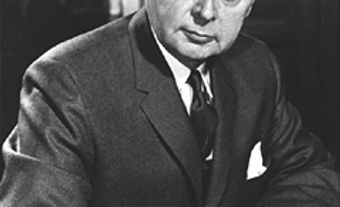The "Diefenbunker" is an underground bunker designed to withstand the force of a nuclear blast. It was built in Carp, Ontario, during a peak in Cold War tensions between 1959 and 1961, and named after then-Prime Minister John Diefenbaker. It is now the location of Canada’s Cold War Museum.
Cold War Anxieties
The 1950s were a time of escalating tension between the American-led West and the Soviet-led communist bloc. Canadians had been shaken by the Suez Crisis of 1956 and the nuclear sabre rattling of new Soviet Premier Nikita Khrushchev, as well as the proliferation of intercontinental ballistic missiles (ICBMs) in both NATO and Soviet bloc countries. In 1957, Khrushchev challenged the United States to a “shooting match,” and the next year he demanded that the West leave Berlin. In 1959, the Cuban Revolution took place, and the communist Viet Cong insurgency was organized in Vietnam. Canada’s geographic position directly between the Soviet Union and the United States put the nation at significant risk.
In response to the growing international crisis, John Diefenbaker announced in 1958 that “development of a decentralised federal system of emergency government with central, regional and zonal elements would proceed.” Diefenbaker authorized construction of a network of nearly 50 nuclear fallout shelters across Canada to protect select members of government in the event of a nuclear attack. The program was named Project EASE (Experimental Army Signals Establishment) as a cover for its true purpose. A Toronto Telegram reporter saw through the cover when he flew over a shelter construction site, and he published his findings, to Diefenbaker’s chagrin.
Five-Megaton Blast
The largest of the emergency government headquarters was built at Canadian Forces Station Carp, in a small town 30 km west of Ottawa. It would have enough supplies to shelter 535 people for 30 days. Occupying more than 100,000 square feet, the bunker consisted of four underground stories and more than 350 rooms, which included a decontamination chamber, medical and dental facilities, a war room, dining facilities and dormitories. The shelter was constructed on a former farm protected by a natural valley, and was within evacuation distance of the capital.
Construction of the shelter — which was designed to withstand a five-megaton nuclear blast — required 32,000 cubic yards of concrete and 5,000 tons of steel. The project cost more than $20 million. A staff of 100 to 150 people worked 24 hour shifts on-site to allow secret communications for the Department of National Defence through the remainder of the Cold War.
Did you know?
Underground bunkers were also built at the provincial level to ensure continuity of government after a nuclear attack. They were known as Regional Emergency Government Headquarters. Six provinces (Nova Scotia, Quebec, Ontario, Manitoba, Alberta, British Columbia) had fully protected underground bunkers constructed on military bases. When the government of Pierre Elliott Trudeau came to power in the 1960s, it stopped further construction. The remaining four provinces (Newfoundland and Labrador, PEI, New Brunswick, Saskatchewan) received “interim non-protected facilities.”
Cold War Museum
In 1994, three years after the collapse of the Soviet Union, the Defence Department decommissioned CFS Carp and withdrew from the site. That same year, it was designated a National Historic Site. Enough members of the public expressed interest in touring the former station that a private development group purchased it and opened the Diefenbunker museum in 1998. The museum was originally operated by volunteers from Carp, who decided to form the Diefenbunker Development Group after the public responded enthusiastically to their tours.
Since its opening, the museum has become one of the most popular tourist destinations in Ontario, drawing nearly 70,000 visitors in 2019. The museum features permanent and rotating exhibitions, and houses more than 3,000 books in its archives and library. Operating as a non-profit organization, the museum is funded through ticket sales, government grants and private donations.

 Share on Facebook
Share on Facebook Share on X
Share on X Share by Email
Share by Email Share on Google Classroom
Share on Google Classroom




